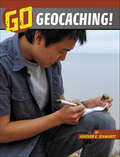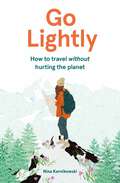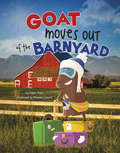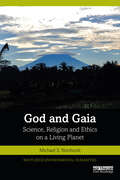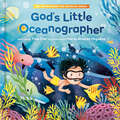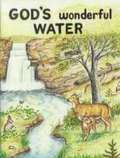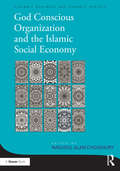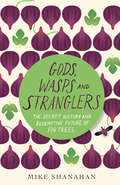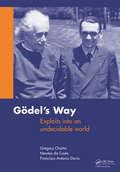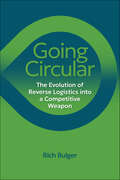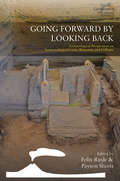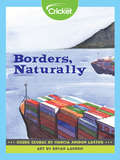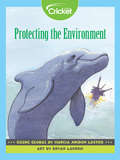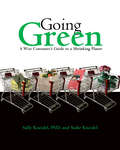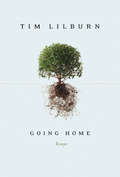- Table View
- List View
Go Gently: Actionable Steps to Nurture Yourself and the Planet
by Bonnie WrightAn inspiring and approachable tip-filled guide to changing your habits, living more sustainably, and taking action, by Greenpeace ambassador Bonnie Wright (Ginny Weasley in the Harry Potter movies)Go Gently is a practical guide for sustainability at home that offers simple, tangible steps towards reducing our environmental impact by looking at what we consume and the waste we create, as well as how to take action for environmental change. The title reflects Bonnie's belief that the best way to change our planet and ourselves is through a gentle approach, rather than a judgmental one. This is an audiobook of do's rather than don'ts. Going through every room in her home, Bonnie helps us assess which products are sustainable, and offers alternatives for those that are not. She shares recipes to avoid food waste, homemade self-care products to avoid packaging, small space friendly gardening ideas and a template for creating your own compost system. Finally, there are exercises and meditation prompts to keep you energised, as well as tips on how to get involved in wider community activism.(P) 2022 HarperCollins Publishers
Go Geocaching! (The Wild Outdoors)
by Heather E. SchwartzHave you always wanted to search for secret treasure? Try geocaching! You can get outside and search for hidden treasure in your very own neighborhood. Learn about geocaching around the world, the supplies you'll need, and the fun that awaits you in this exciting activity!
Go Geocaching! (The Wild Outdoors)
by Heather E. SchwartzHave you always wanted to search for secret treasure? Try geocaching! You can get outside and search for hidden treasure in your very own neighborhood. Learn about geocaching around the world, the supplies you'll need, and the fun that awaits you in this exciting activity!
Go Green!: Join the Green Team and learn how to reduce, reuse and recycle
by Liz GogerlyIt's Anjali's birthday party and the children have had a great time. But looking around the room at the end, they see mountains of rubbish, from food waste to wrapping paper, burst balloons and small plastic toys. What will happen to all of this waste?The children find out what happens at a recycling centre and about the huge amount of objects that can be recycled or reused. They learn how to take action outside by helping nature, reducing waste at school dinners, and saving energy and water at home. Through chatting to teachers and local people, the children learn all about green topics such as landfills, litter, plastic mountains in oceans and global warming. But it's not all doom and gloom. They discover that there are ways that they can take action to help save their environment and the planet. By walking to school or switching off lights when they don't need them, this book is full of ideas for reducing and reusing. At the end they hold a fun Eco Festival to raise awareness of how easy it is to 'go green'! 'Stop and Think' panels encourage readers to think about the problem in their local area and 'Take Action' panels give advice for how readers can get involved.Look out for the other titles in this series: Wild Weather!, Save Our Seas! and Nature Needs You!
Go Green, Live Rich
by David Bach Hillary RosnerLet David Bach show you a whole new way to prosper—by going greenInternationally renowned financial expert and bestselling author David Bach has always urged readers to put their financial lives in line with their values. But what if your values are a cleaner and greener earth? Most people think that “going green” is an expensive choice they can’t afford. Bach is here to say that you can have both: a life in line with your green values and a million dollars in the bank. Go Green, Live Richoutlines fifty ways to make your life, your home, your shopping, and your finances greener—and get rich trying. From driving the right car to making your home energy smart, Bach offers ways to improve the environment while you spend less, save more, earn more, and pay fewer taxes. Best of all, he shows you exactly how to take advantage of the "green wave" in personal finance without the difficult work of evaluating individual stocks. What's more, he will get you thinking about a green business of your own so you can help the world along as it is changing for the better. David Bach is on a mission to teach the world that you can live a great life by living a green life. WithGo Green, Live Rich, you can live in line with your eco-values on the road to financial freedom.
Go Green, Live Rich: 50 Simple Ways to Save the Earth and Get Rich Trying
by David Bach Hillary RosnerLet David Bach show you a whole new way to prosper--by going green. Internationally renowned financial expert and bestselling author David Bach has always urged readers to put their financial lives in line with their values. But what if your values are a cleaner and greener earth? Most people think that "going green" is an expensive choice they can't afford. Bach is here to say that you can have both: a life in line with your green values and a million dollars in the bank. Go Green, Live Rich outlines fifty ways to make your life, your home, your shopping, and your finances greener-- and get rich trying. From driving the right car to making your home energy smart, Bach offers ways to improve the environment while you spend less, save more, earn more, and pay fewer taxes. Best of all, he shows you exactly how to take advantage of the "green wave" in personal finance without the difficult work of evaluating individual stocks. What's more, he will get you thinking about a green business of your own so you can help the world along as it is changing for the better. David Bach is on a mission to teach the world that you can live a great life by living a green life. With Go Green, Live Rich, you can live in line with your eco-values on the road to financial freedom.
Go Green: How to Build an Earth-Friendly Community
by Nancy H. TaylorGo Green is an indispensable resource for the grown-up greenies who have accepted the philosophy and are ready to spread it beyond just their own homes. Go Green offers user-friendly suggestions and case studies for individuals, schools, hospitals, businesses and communities on building or remodeling a green home, starting green programs in the classroom or at hospitals, and finding out what really matters about transportation, food, and renewable energy.
Go Lightly: How to travel without hurting the planet
by Nina KarnikowskiThis sustainable travel handbook inspires readers to explore our fascinating planet without causing it further harm. Ten chapters help you go lightly, including how to choose the least impactful methods of travel, how best to protect wildlife, how to pack with more consideration and how to implement mindful practices into each travel day, Go Lightly gives the reader a tool kit of fresh ideas for travelling more consciously. The book also covers eco-friendly activities including biking, boating and camping, and introduces us to some of the world's most inspiring eco-adventure pioneers.
Go Lightly: How to travel without hurting the planet
by Nina KarnikowskiThis sustainable travel handbook inspires readers to explore our fascinating planet without causing it further harm. Ten chapters help you go lightly, including how to choose the least impactful methods of travel, how best to protect wildlife, how to pack with more consideration and how to implement mindful practices into each travel day, Go Lightly gives the reader a tool kit of fresh ideas for travelling more consciously. The book also covers eco-friendly activities including biking, boating and camping, and introduces us to some of the world's most inspiring eco-adventure pioneers.
Go Wild! Lions (Go Wild!)
by Margie MarkarianPlay, pounce, hunt, and ROAR with lions in this lively introduction to these powerful big cats! Learn all about lions, including their awesome body parts, how they hunt, and what life is like in a pride. Little kids will go wild over photos of adorable lion cubs and more as they explore: Where lions live What their families are like How lion babies grow up Other amazing wild cats How lions communicate And moreYoung readers will also find out why lions need our help and what people around the world are doing to protect them. Filled with fun facts, awesome photos, games, and activities that will inspire kids to care about these amazing animals. Complete your collection with: Go Wild! Pandas Go Wild! Sea Turtles Go Wild! Elephants Go Wild! Lemurs
Goat Moves Out of the Barnyard (Habitat Hunter)
by Nikki PottsGoat is bored with its habitat! Follow Goat as it tries out different places to live. Which habitat will make the best home for Goat?
God and Gaia: Science, Religion and Ethics on a Living Planet (Routledge Environmental Humanities)
by Michael S NorthcottGod and Gaia explores the overlap between traditional religious cosmologies and the scientific Gaia theory of James Lovelock. It argues that a Gaian approach to the ecological crisis involves rebalancing human and more-than-human influences on Earth by reviving the ecological agency of local and indigenous human communities, and of nonhuman beings. Present-day human ecological influences on Earth have been growing at pace since the Scientific and Industrial Revolutions, when modern humans adopted a machine cosmology in which humans are the sole intelligent agency. The resultant imbalance between human and Earthly agencies is degrading the species diversity of ecosystems, causing local climate changes, and threatens to destabilise the Earth as a System. Across eight chapters this ambitious text engages with traditional cosmologies from the Indian Vedas and classical Greece to Medieval Christianity, with case material from Southeast Asia, Southern Africa and Great Britain. It discusses concepts such as deep time and ancestral time, the ethics of genetic engineering of foods and viruses, and holistic ecological management. Northcott argues that an ontological turn that honours the differential agency of indigenous humans and other kind, and that draws on sacred traditions, will make it is possible to repair the destabilising impacts of contemporary human activities on the Earth System and its constituent ecosystems. This book will be of considerable interest to students and scholars of the environmental humanities, history, and cultural and religious studies.
God's Little Oceanographer (Big Adventures for Growing Minds)
by Tina ChoRide the waves before diving into the depths of sea to uncover the wonders of the ocean—and God&’s deep love for you and me!From the ocean's surface, all the way to its deepest depths, this immersive picture book will teach little sea lovers new words, facts, and concepts, while also encouraging them to see God's creativity, playfulness, power, and love in every splash and every wave. Written by an elementary school teacher, each page includes fact-filled sidebars plus an accompanying Bible verse, making God's Little Oceanographer the perfect faith friendly science adventure for kids interested in marine life and activities. The masterfully layered and rich illustrations include sharks, dolphins, otters, sea turtles, whales, octopuses, and so much more!
God's Wonderful Water
by Mary Landis Virginia KreiderLeading little ones to love, worship, and trust God as they study the amazing ways that water supports life on earth.
God-Conscious Organization and the Islamic Social Economy (Islamic Business and Finance Series)
by Masudul Alam ChoudhuryCan there be God-conscious organizational behaviour in the real world of today’s capitalist corporations and the alternatives? In this overview of God-consciousness as a moral-awareness model of preference formation, functions, structures, and programs of organization within the purview of institutions and society, the authors explain and compare the major ethical issues of organizational behaviour and structure in Islamic economic theory and application. By analysing the nature of inclusive organizations and institutions, and the ethical preferences in Islamic choice framework, the authors from Saudi Arabia, Australia, Malaysia, Bangladesh, Canada, Indonesia and the UK, can highlight individual aspects to show whether capitalist organizational behaviour is sustainable. They describe how The Tawhidi epistemological framework governing conscious moral decision-making by institutions and organization, are used to establish the meaning and potential application of the concept of sustainability, and whether organizational moral objectives achieve their goals of life-fulfilment development, Poverty alleviation and the equitable distribution of wealth and resources.
Gods, Wasps and Stranglers: The Secret History and Redemptive Future of Fig Trees
by Mike Shanahan&“If you&’re looking for a dose of wonder in your reading life, I recommend this beautiful book about the magic of fig trees.&”—Book RiotOver millions of years, fig trees have shaped our world, influenced our evolution, nourished our bodies and fed our imaginations. And as author and ecologist Mike Shanahan proclaims, &“The best could be yet to come.&”Gods, Wasps and Stranglers weaves together the mythology, history and ecology of one of the world&’s most fascinating—and diverse—groups of plants, from their starring role in every major religion to their potential to restore rainforests, halt the loss of rare and endangered species and even limit climate change.In this lively and joyous book, Shanahan recounts the epic journeys of tiny fig wasps, whose eighty-million-year-old relationship with fig trees has helped them sustain more species of birds and mammals than any other trees; the curious habits of fig-dependent rhinoceros hornbills; figs&’ connection to Krishna and Buddha, Jesus and Muhammad; and even their importance to Kenya&’s struggle for independence.Ultimately, Gods, Wasps and Stranglers is a story about humanity&’s relationship with nature, one that is as relevant to our future as it is to our past.&“Surprising, engrossing, disturbing and promising, Gods, Wasps and Stranglers combines masterful storytelling and spellbinding science. This is a beautifully written and important book about trees that have shaped human destiny.&”—Sy Montgomery, author of The Soul of an Octopus
Goedel's Way: Exploits into an undecidable world
by Gregory Chaitin Newton da Costa Francisco DoriaKurt Gödel (1906-1978) was an Austrian-American mathematician, who is best known for his incompleteness theorems. He was the greatest mathematical logician of the 20th century, with his contributions extending to Einstein’s general relativity, as he proved that Einstein’s theory allows for time machines.The Gödel incompleteness theorem - the usual formal mathematical systems cannot prove nor disprove all true mathematical sentences - is frequently presented in textbooks as something that happens in the rarefied realms of mathematical logic, and that has nothing to do with the real world. Practice shows the contrary though; one can demonstrate the validity of the phenomenon in various areas, ranging from chaos theory and physics to economics and even ecology. In this lively treatise, based on Chaitin’s groundbreaking work and on the da Costa-Doria results in physics, ecology, economics and computer science, the authors show that the Gödel incompleteness phenomenon can directly bear on the practice of science and perhaps on our everyday life.This accessible book gives a new, detailed and elementary explanation of the Gödel incompleteness theorems and presents the Chaitin results and their relation to the da Costa-Doria results, which are given in full, but with no technicalities. Besides theory, the historical report and personal stories about the main character and on this book’s writing process, make it appealing leisure reading for those interested in mathematics, logic, physics, philosophy and computer sciences. See also: http://www.youtube.com/watch?v=REy9noY5Sg8
Goethe als Naturforscher im Urteil der Naturwissenschaft und Medizin des 19. Jahrhunderts: Themen, Texte, Titel
by Dietrich von EngelhardtGoethe als Naturforscher findet bei deutschen und ausländischen Naturforschern und Medizinern des 19. Jahrhunderts durchgängig Beachtung und führt zu einer Fülle spezifischer Goethe in dieser Hinsicht gewidmeten Studien mit Interpretationen und Beurteilungen – neben wiederholt vorkommenden knapperen Ausführungen oder kurzen Hinweisen in naturwissenschaftlichen und medizinischen Publikationen der Zeit. Übergreifende Veröffentlichungen über Goethe und die Romantik, über seine Stellung in Europa, über seine Beziehungen zu England, Frankreich, Italien, Spanien, den skandinavischen und slavischen Ländern behandeln meist nur seine literarischen und geisteswissenschaftlichen Werke und gehen allenfalls begrenzt auf seine naturwissenschaftlichen Beiträge und ihre Aufnahme in den Naturwissenschaften und Medizin ein. Diese fachspezifische Zurückhaltung gilt auch für Bibliographien der Übersetzungen deutscher Veröffentlichungen des 19. Jahrhunderts in europäische Sprachen; naturwissenschaftliche und medizinische Publikationen kommen in ihnen nicht oder nur sporadisch vor. Der vorliegende Band schließt diese Lücke. Neben einer umfassenden Bibliographie von 260 Titeln von Naturwissenschaftlern und Medizinern über Goethe als Naturforscher steht eine Wiedergabe von 48 entsprechenden nicht nur deutschen, sondern vor allem auch internationalen und oft an entlegenen Orten erschienenen Arbeiten.
Going Circular: The Evolution of Reverse Logistics into a Competitive Weapon
by Rich BulgerThe essential business guide for using reverse logistics to drive profits, growth, and sustainability. Long considered a &“necessary evil&” of doing business, reverse logistics is quickly becoming the key to staying competitive in today&’s dynamic marketplace. In Going Circular, RecirQ Global CEO Rich Bulger reveals its potential for boosting revenue, enhancing customer experience, and supporting the circular economy. Urging a strategic shift, Going Circular showcases how integrating reverse logistics in sales, marketing, and customer retention can achieve broader business objectives, including cost reduction and environmental responsibility. It offers practical strategies for minimizing unwanted returns and repurposing products, fostering sustainable business models and market expansion. Comprising seven comprehensive chapters and three &“reUse&” case studies, this guide redefines reverse logistics as a vital tool for business resilience and success. A must-read for professionals in the field, Going Circular is a call to action for integrating reverse logistics into evolving business strategies, promising a pathway to sustainable transformation and profitability.
Going Circular: Unlocking the potential of regions and cities to drive the circular economy transition (Regional Studies Policy Impact Books)
by Joanna Williams Marcin Dąbrowski Karel Van den Berghe Ellen Van BuerenGoing Circular explores the concept of a circular economy (CE) and its transformative potential for cities and regions. It emphasises the importance of spatial planning and the role of urban and regional authorities in driving the transition to a more sustainable, resilient and inclusive economic and societal model. The authors offer a critical perspective, arguing that there is no onesize-fits-all approach to regional and urban CE policies. Instead, they advocate for a context-specific understanding of CE, emphasising the importance of: local and regional conditions for circular activities; the spatial patterns in resource stocks and flows within territories, and the need to engage a range of stakeholders and communities in decision-making processes.Going Circular tackles the pivotal policy issues and challenges related to CE transitions in cities and regions. It will inform and equip public and private policymakers, urban planners and regional authorities with the knowledge and tools needed to foster a CE and nudge cities and regions towards sustainable futures.Despite extensive data and knowledge available on cities and regions, terms such as ‘circularity’, ‘economy’ and ‘space’ often remain disjointed for researchers, policymakers and practitioners alike. This book presents a frank and insightful exploration of the spatial dimension of the circular economy, challenging assumptions and idealisms. It provides practical opportunities for action by underscoring the importance of geopolitics, empathy and justice, ecosystems restoration, and assessment of progress on the transition pathways towards a circular economy. The book equips readers with language and visual concepts needed to engage with and communicate this topic confidently. I highly recommend it as both an introduction and a refresher on the topic of circular regions and cities.Adrian Vickery Hill, Strategist and designer - director, Osmos NetworkThis book outlines a path to trigger circular economy processes that can transform cities and regions, guiding them towards a more resilient and sustainable future, while producing context-appropriate solutions. Circular economy is a context-specific, place-based process that requires a holistic and systemic perspective, in which space plays a crucial role. In six thematic chapters, the book proposes a pathway analysing several key issues: the spatial dimension of circular economy; the opportunities for more ecologically healthy, resource-sufficient metropolitan regions; the integration of social justice and the concept of “care-full” circular economy; the ecological implications of the transition in line with the urban circular bioeconomy; the multidimensional assessment of the transition progress and cross-level interdependencies; as well as policy recommendations for multi-level governance at various scales. This book provides an inspiring perspective on circular economy, not only as a technical and economic challenge, but also as a social and political opportunity. It is highly recommended for anyone interested in fostering a more sustainable and circular future for our cities.Prof. Maria Cerreta, University of Naples “Federico II”
Going Forward by Looking Back: Archaeological Perspectives on Socio-Ecological Crisis, Response, and Collapse (Catastrophes in Context #3)
by Felix Riede and Payson SheetsCatastrophes are on the rise due to climate change, as is their toll in terms of lives and livelihoods as world populations rise and people settle into hazardous places. While disaster response and management are traditionally seen as the domain of the natural and technical sciences, awareness of the importance and role of cultural adaptation is essential. This book catalogues a wide and diverse range of case studies of such disasters and human responses. This serves as inspiration for building culturally sensitive adaptations to present and future calamities, to mitigate their impact, and facilitate recoveries.
Going Global: Borders, Naturally
by Marcia Amidon LustedCheck out these famous countries and regions that owe their shapes to an important geographic feature. These features help dictate so much about the countries they border.
Going Global: Protecting the Environment
by Marcia Amidon LustedSometimes, preservation and conservation need to occur on a larger scale. Oceana, Greenpeace, and the World Wildlife Fund are dedicated to protecting resources all over the world—especially resources that all people share.
Going Green
by Sally Kneidel Sadie KneidelGoing Green focuses on the biggest environmental culprits of the American lifestyle--diet, housing, clothing, and transportation--and provides practical, effective steps we can take to reduce our carbon footprint and live more sustainably. Comprehensive and empowering, it will make you think twice about every dollar you spend.
Going Home: Essays
by Tim LilburnLike his contemporaries Robert Bringhurst, Ronald Wright, Dennis Lee, Don McKay, and Jan Zwicky, Tim Lilburn has long been a deep thinker on issues of ecology and writing, and on how the two fit together philosophically, morally, and ethically. In Going Home, Lilburn addresses how we relate (often uneasily) to our physical landscape in Canada and the United States.Retrieving an almost lost strand in the Western intellectual tradition -- the erotic, contemplative strand, from Plato to John Cassian to the Areopagite -- Lilburn traces a history of eros and desire in the hope that this exercise and its awakening can lead us home to a full residence in North America. Surprising and enlightening, the collection finishes with two unforgettable personal essays, where Lilburn writes about his effort to enact desire in the place where his ancestors are buried, the flatlands and coulees of southern Saskatchewan.


